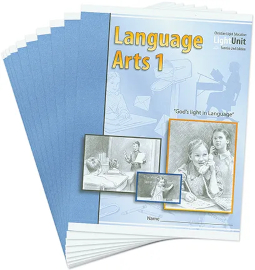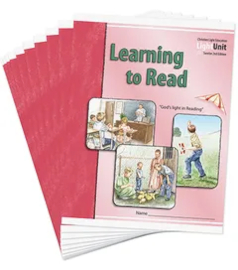Christian Light Education offers complete language arts courses for grades one through twelve. This review focuses on the courses for only first and second grade since they both teach phonics and use the same sets of phonics cards. (Read my review of their reading and language arts courses for grades 3 to 8 here.)
These courses are part of Christian Light's Sunrise curriculum, and the reading and language arts courses are now in their second editions. These editions teach in a spiral fashion, presenting small increments of new instruction along with continual review—about 30% of a lesson exercise is new material, while 70% is review.
Rather than textbooks, students have a set of five to ten LightUnit booklets for each course. The consumable LightUnit booklets are printed with only two or three colors. Learning to Read and Reading 1 booklets include tests. For Language Arts 1 and 2 and Reading 2, each booklet includes two quizzes and a test that should be removed until time to use it.
All Sunrise courses have accompanying Teacher's Guides featuring reduced images of student pages from LightUnits with overprinted answers. Additional instructions and information for the teacher surround the student pages. Several appendices at the back of each Teacher’s Guide have resources, such as alternate tests, various types of indices, a scope and sequence, and a glossary. The reading Teacher’s Guides add resources, such as reproducible pages used with the lessons, suggested books to read, and the Scripture verses for each story. The language arts Teacher’s Guides add to their appendices lists of spelling words and spelling tests with sentences. Some levels also have phonics rules, penmanship tips, and handwriting models.
The hardcover readers for the courses have full-color illustrations throughout and lists of new words at the back.
Grade 1
Christian Light's first grade program for language arts consists of three separate courses. Children begin with Learning to Read, which has 108 lessons that should take a little over five months to complete. The Language Arts 100 course is brought in part way through the fifth (of 10) Learning to Read LightUnits and continues through the end of the school year. Reading 1 is begun after completing Learning to Read. Clear instructions and charts are provided to show the coordination of resources, so it's not as complicated as it sounds, and all three components can be completed in 168 days (34 weeks).
Learning to Read
Learning to Read's primary components are ten LightUnits, two Teacher's Guides, Letter Cards (with a picture for each letter; available as flashcards or wall cards), 224 Word Flash Cards, 228 Phrase Flash Cards, and four primers (each with 48 to 73 pages). Optional items are Sight Word Flash Cards, a Sound Slider (tool for helping students work with blending), and Practice Sheets (two books of reproducible worksheets).
This course focuses on phonics, while also providing other introductory language arts instruction, including some handwriting. It begins with letters and their sounds, emphasizing the sounds of the letters rather than letter names during initial instruction. As lessons progress, the names of the letters are used more frequently. The course continues through phonograms like igh, spr, and thr and words like praying, right, and beamed that are taught in the final LightUnit. That might sound like a lot for one school year, but most children will already have some exposure to letters and sounds before first grade and should find it manageable. Spelling, introduced in the second LightUnit, is taught as a reinforcement for phonics, and spelling lists are at the back of the Teacher’s Guide.
Learning to Read is very teacher-intensive, but the lessons are scripted to make it easy for the inexperienced or time-pressed teacher or parent.
The course does not presume that students have had prior phonics instruction, but it moves relatively quickly. At first, it teaches blending sounds through words grouped by their middle vowel sounds, such as dad, sad, and dam. Sight words, such as do and the, are presented throughout the course so that children can read stories written in more natural language from the four primers. (Some sight words, such as brown and please, are actually phonetic, but children have not yet learned the phonograms in those words.)
The four primers are printed in black and white. The first one has more illustrations than text, and this ratio gradually reverses with the fourth primer’s three-page stories each having only one illustration. The reading material within the Teacher’s Guides and the primers is uplifting and God-honoring. Illustrations show people wearing clothing typical of the Mennonite community—modest clothing, head coverings for women, long pants for boys, and dresses for girls.
The course is traditional in its approach: pages in the LightUnits look like traditional phonics or reading workbooks, and flashcards help with repetition and memorization. However, the Teacher’s Guide has the parent or teacher use stories, rhymes, hand movements, air-writing, discussion of stories, and other multi-sensory learning strategies that keep things interesting.
Reading 1
Reading 1 is the next step after Learning to Read and should take one semester. It consists of I Wonder (a 223-page hardcover reader), a Teacher's Guide, and five LightUnits. It continues with phonics instruction but increasingly focuses on reading comprehension. Each week students learn a Bible verse and discuss its relation to the story.
Lessons are taught through interaction. Reading 1 is not as fully scripted as Learning to Read but does have detailed lesson plans. The parent or teacher writes several items on a whiteboard or chalkboard: new words, Bible verses, vowels with diacritical markings, names of story characters, sentences, questions, and other instructional items to be used during the lesson. Most lessons begin with brief review, and new words are taught before students try to read them. Sometimes new words are taught with phonetic spellings so children learn how to sound them out. The Bible verse is practiced once or twice every day. Children will read aloud from the reader and answer questions provided in the Teacher’s Guide. Children also learn critical thinking as they answer questions regarding sequence, cause and effect, and the motivations of characters.
The teacher works with children through activities in the LightUnits to reinforce learning. While it’s possible to teach directly from the LightUnits once you’ve understood how the course works, without the Teacher’s Guide you will be missing important lesson components, such as the review at the beginning of the lessons and the discussion questions. Tests at this level are very similar to the workbook activities. The Reading Assessment rubric in the Teacher’s Guide Appendix F should be helpful for assessing actual reading ability.
The design of the activities varies from day to day. They might ask students to underline or circle items, match columns, color an item representing the correct answer, write words from a word bank, cross out incorrect words, sequence items, draw pictures, or complete sentences.
The reader used with the Reading 1 course, I Wonder, is a collection of short stories and poems. While they are not overly difficult, they are not vocabulary controlled. That makes prior introduction of new words especially important. The content is thoroughly Christian. For instance, the first story includes a discussion led by the father about a neighbor’s barn burning down after being struck by lightning. That discussion includes the troubling question of why God lets things like this happen. This story is followed by a poem about thunder that ends with the line, “I know it is God’s voice, so it doesn’t scare me.” Other stories emphasize positive character traits such as telling the truth, saying please, and developing good habits.
 Language Arts 1
Language Arts 1
Language Arts 1 correlates with the other two courses, although it can also be used alongside a different phonics program. The integration of the courses is a little tricky, but the schedules near the beginning of each book tell what to use when.
Ten LightUnits and a Teacher’s Guide are the essential components, but you can also purchase a set of practice sheets, phonics cards, and I Can Write Manuscript.
Language Arts 1 continues with phonics instruction, while also teaching spelling, introductory grammar (e.g., capitalization, punctuation, contractions), and penmanship. It introduces creative writing in the seventh LightUnit. Two quizzes are also included within each LightUnit.
Students might be able to complete much of their LightUnits work on their own once they understand the instructions. Lessons on creative writing require teacher involvement.
As with other LightUnits for first grade, activities vary widely in format and gradually increase the amount of writing required.
Grade 2
The language arts program for second grade consists of two, year-long courses: Reading 2 and Language Arts 2. They are not integrated, and either course might be used on its own. Both courses have 10 LightUnits. Reading 2 has two Teacher’s Guides and two hardcover readers: Helping Hands and Happy Hearts. Language Arts 2 has one 496-page Teacher’s Guide. The sets of phonics flashcards for first grade can also be used with Language 2 but are not required.
The courses work very much like those for first grade, except students are expected to be able to do more of their work independently. The LightUnits include frequent boxes the student needs to check to show they have completed assignments and circles where a supervisor needs to initial that the work has been checked before the student can move on. Smaller circles require a supervisor’s initials but still allow the student to continue working in the interim.
Each LightUnit has two quizzes, a Self Check, and a test. Parents should remove the tests until they are needed.
Reading 2
Reading 2 requires less instruction on a whiteboard or chalkboard, but the Teacher’s Guide includes reviews and discussion questions not present in the LightUnits, as in the first-grade program. Reading comprehension questions include questions in three categories: literal, inference, and application.
Students memorize a Bible verse for each story in their readers, and those verses are discussed in relation to the stories.
Language Arts 2
Language Arts 2 LightUnits often include one- or two-page reading passages that reinforce reading skills and teach other ideas and information, such as the importance of caring for books, the value of good nutrition, about the four seasons, and how to look up names in a telephone book. (Since few people have telephone books anymore, a sample telephone book page is included in the LightUnit.)
Students learn about nouns, verbs, and adjectives, and are briefly introduced to diagrams for those sentence elements. They learn other aspects of grammar and usage, such as capitalization, punctuation, compound sentences, the use of quotation marks, and present and past tense verbs.
Composition skills expand with paragraphs, thank-you notes, friendly letters, book reports, and creative writing. Suggested topics and tips for creative writing are in Appendix D of the Teacher’s Guide.
For spelling, students are given a list of 15 words to learn for every eight lessons; they have three such lists per LightUnit. Rather than testing on all of the words, quizzes assess mastery of 10 words, and tests assess 20 words. Students cut out bookmarks with their spelling word lists from the back of each LightUnit and insert them in the booklet to keep handy for review.
Cursive handwriting instruction begins with Lesson 11 but might be delayed if students are not ready. It is taught again in third grade.
Summary
Christian Light’s Reading and Language Arts courses for first and second grade integrate language arts to provide thorough coverage. You don’t need anything else for any area of language arts. The courses do require significant teaching time, especially for first grade, but the Teacher’s Guides are easy to follow and can be used with minimal prep time. And the content of these courses might be a major factor for many families looking for support of their Christian faith and values.










